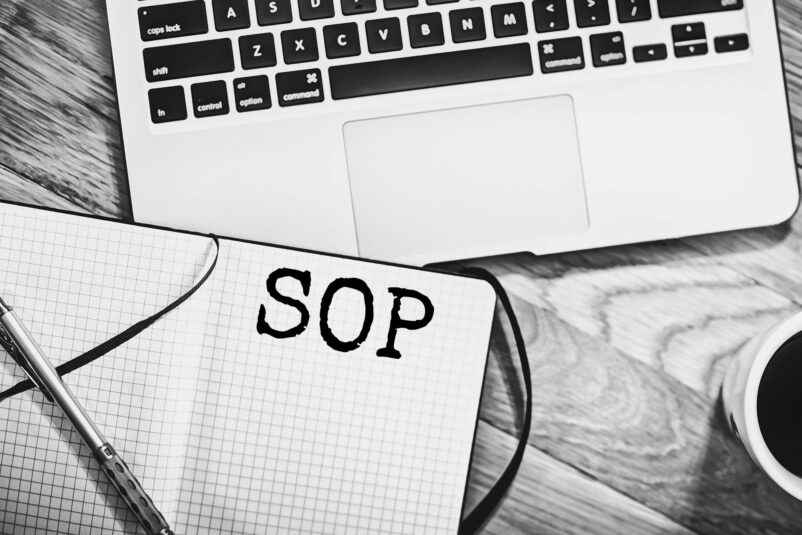In the past, we have talked about how important it is for a growing business to delegate tasks to other employees. To effectively run a business and give tasks to others, without getting stressed, a standard operating procedure is a must. Here are tips on 10 ways to write better SOPs for your business so you can boost your efficiency and save yourself time.
Writing good standard operating procedures is an essential aspect of running a business. SOPs can save precious time and money as you train new employees, try to comply with industry laws and regulations, and ensure that everyone in the business knows how things work.
Of course, writing standard operating procedures is one part of the story. The actual effectiveness of them will depend on several things. For instance, are they easily accessible? Are they written in a language/ format that is easy to understand? Does your SOP mirror the real situation on the ground? Has everyone involved in the business bought into the documented procedures?
To ensure that your growing business receives the maximum benefit from SOPs, here are ten things you can do.
10 Ways to Write Better Business Standard Operating Procedures (SOPs)
1. Get the Right Person to Write the SOP
Creating a comprehensive and well-presented process document may not be what you are good at, but you can always identify a member of your staff who has the requisite writing skills and experience with the process you are outlining.

Of course, if your team does not have the time to document processes, you can always hire an outside process writing agency. Regardless of who writes it, it’s essential to have someone who knows the process inside and out involved to ensure the accuracy of the SOP.
2. Create Visual SOPs
Not everyone retains information in the same way. Some people are visual learners while others may prefer reading. This is why adding images, videos, and flowcharts to SOPS is highly suggested.
In most instances, it will make the process both easier to read and retain for all types of learners.
As an example, if you have a salon, it could be boring for staff to go through a textual description of how you would like them to do a pedicure or manicure. By adding a video, you can give detailed directions quickly. Plus, it becomes easier for staff to view the SOP video via their mobile devices.
3. Write SOPs for Your Target Audience
As a former banker, I was often reviewing process notes written in similar style/language, regardless of the level of staff handling those processes. Failure to write for the target audience is probably the reason why many SOPs fail to hit the mark.
To avoid making the same mistake, invite someone outside the SOP writing team to view the completed document. Doing this will help identify if there is more information than needed to understand a step, or if some sections of the SOP require further detailing.
4. Use a Positive Writing Style
In ‘5 Mistakes Companies Make with their Standard Operating Procedures’ by video production company Digicastj, they raise a vital point: when writing instructions, focus on the dos rather than the don’ts.
For example, if you want your blog writer to include at least two high-quality images per post, specify it as ‘Include two images with a resolution of at least 300 dpi’, instead of saying ‘Don’t use low-resolution images.’
Adding too many don’ts can sound dictatorial and may even put off the person who has to execute the process.
5. Use an SOP Creation Tool
A smarter way to write standard operating procedures for the modern business place is to use a comprehensive workflow management system like Process Street. The drag and drop feature of the platform makes it easy to create a structured process document.
With their tool, you can add videos and images, take screenshots of an uploaded video, generate process checklists, create SOP templates, and even track progress on tasks assigned to your team.
Some of the other SOP writing apps you can check out are Pipefy, Trello, and Zip Checklist.
6. Do an On-Ground Assessment Before Documenting an Existing Process
When creating an SOP, don’t just record the current process.

Use this as a time to analyze any needed changes. Question every step and assess if you still need to do everything. There may be steps that can be deleted or information that requires updating (e.g., an invalid email given as part of the organization escalation matrix).
7. Test the SOP if You are Launching a New Process
Depending on how important a process is, share the new standard operating procedure via a telephone call, video chat, or do an in-person training session.
This is a great way to determine if the SOP is complete or needs more edits. And before you go live with the process, do a pilot launch to assess whether those responsible have a clear understanding of their roles.
8. Explain the ‘WHY’ to Build Buy-in

It’s imperative that all members of your team understand the ‘why’ of each process and how what they do impacts the successful completion of the task. Talk them through possible failure scenarios at different stages of the process and the resulting outcomes.
The more they understand the importance of their role in the process, the more likely they are to take care when completing their part.
9. Get Written Consent from Everyone Involved in the SOP
Get a sign-off from people involved in implementing the process on their agreement with the final process. Even an email confirmation would do.
Although written confirmations on processes may sound old-school, it helps to create a sense of accountability to ensure that the managers and staff have taken the time to read and understand the process.
10. Review Old SOPs
Revisit SOPs written more than two years ago to see how they can be revised to save time, reduce the cost of functioning, maximize business resources, or to enhance the end-customer experience.
“The best SOPs are the product of an iterative process. You can’t cover every eventuality without running the process in practice, so we’ve found it’s best to get a draft SOP deployed as fast as possible and make optimizations over time.” – Vinay Patankar, CEO Process Street
If changes are made to an SOP, ensure that all team members involved in the process are aware. If you use process writing apps like Zip Checklist, they have the option of instantly notifying employees of revisions in a process note, which can save you time.
For any business, making sure all of your employees know how to properly complete any task is a great way to boost the productivity of your business and decrease your stress. By implementing these ten easy ways to write strong standard operating procedures, you’ll boost both the productivity of your team and ensure quality and consistency in all you do.
What is your number one tip for writing SOPs for a growing business? Please share in the comments box below.











Unlike making the content filled with technicalities, the article presents many practical aspects of SOP writing. That was a good read.